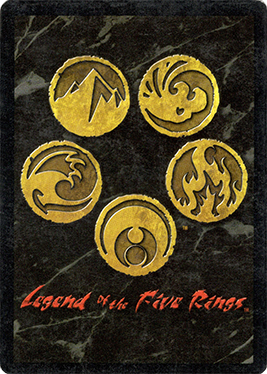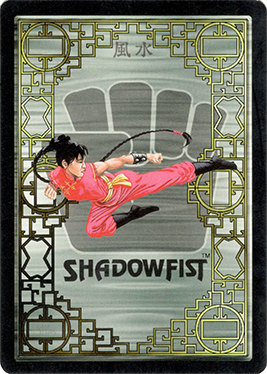
In collectible card games, digital collectible card games and collectible miniature wargames, a booster pack is a sealed package of cards or figurines, designed to add to a player's collection. A box of multiple booster packs is referred to as a booster box.

The Lord of the Rings Trading Card Game is an out-of-print collectible card game produced by Decipher, Inc. Released November 2001, it is based on Peter Jackson's The Lord of the Rings film trilogy and the J. R. R. Tolkien novel on which the films were based. Decipher also had the rights to The Hobbit novel but did not release any cards based on it. In addition to images taken from the films, in 2004 Weta Workshop produced artwork depicting characters and items from the novel absent from the films for use on cards. In 2002, LOTR TCG won the Origins Awards for Best Trading Card Game of 2001 and Best Graphic Presentation of a Card Game 2001. Decipher's license to The Lord of the Rings expired on July 30, 2007, after which all official promotion and distribution of the game stopped.

Spellfire: Master the Magic is an out-of-print collectible card game (CCG) created by TSR, Inc. and based on their popular Dungeons & Dragons role playing game. The game appeared first in April 1994, shortly after the introduction of Magic: The Gathering, in the wake of the success enjoyed by trading card games. It was the second CCG to be released, preceding Wizards of the Coast's second CCG Jyhad by two months. More than one dozen expansions for the game were released, and the final expansion was released in October 1997.
Vampire: The Eternal Struggle is a multiplayer collectible card game published by White Wolf Publishing. It is set in the World of Darkness and is based on the Vampire: The Masquerade roleplaying game.

Legend of the Five Rings (L5R) is an out-of-print collectible card game created by a joint venture featuring Alderac Entertainment Group and ISOMEDIA in 1995 and published until 2015, when it was announced that the game would be discontinued for a rules-incompatible successor that will be part of Fantasy Flight Games' Living Card Game line. L5R takes place in the fictional empire of Rokugan from the Legend of the Five Rings setting, where several clans and factions vie for domination over the empire.

Redemption is a collectible card game based on the Bible. It involves Biblical characters, places, objects, and ideas. The object of the game is for players to use their Heroes to rescue Lost Souls by defeating their opponent's Evil Characters, with the first player to rescue five Lost Souls winning the game. Redemption was first published in July 1995 by Cactus Game Design and its creator, Rob Anderson, continues to develop and produce the game and is the final authority on rulings.
Ice Age is a block of three expansion sets in Magic: The Gathering, consisting of the Ice Age, Alliances and Coldsnap sets. It is also the titular first set in the block. The Ice Age set is the eleventh set and the sixth expansion set, previewed at the Canadian Card and Comics Spectacular in early June 1995, and released later that month. Set in the years from 450 to 2934 AR, the set describes a world set in perpetual winter due to the events in Antiquities. Ice Age was followed up June 1996 with Alliances, the fourteenth Magic: The Gathering set and eighth expansion set.; and on July 21, 2006 with Coldsnap. The time period between Alliances and Coldsnap was the longest period of time between the beginning and the completion of a full block in Magic. Originally, the set Homelands, released in October 1995, was the second set in the Ice Age block, but following the release of Coldsnap, Homelands was removed from the block in favor of Coldsnap.

Shadowfist was created by Robin Laws and Jose Garcia. It was released in June 1995 as a collectible card game (CCG), but was shifted to a fixed distribution of cards as of 2013. It shares the same background as the Feng Shui, a role-playing game created by Laws and Garcia and released the following year. In September 2018 ownership of Shadowfist switched to Vetusta Games.

Dragon Ball Z Trading Card Game is an out-of-print trading card game based on the Dragon Ball series created by Akira Toriyama. The game was produced by Score Entertainment and uses screen captures of the anime to attempt to recreate the famous events and battles seen in the anime. Score then sold the rights to Panini which eventually ceased publishing.

Dixie is an out-of-print collectible card game that uses dice and special trading cards to allow players to refight famous American Civil War battles, such as the battles of First Bull Run, Shiloh, and Gettysburg. It was produced in 1994 by Columbia Games with rules loosely based on its 'wooden block' series of games.

Wildstorms is an out-of-print collectible card game (CCG) published in October 1995. It was developed under the Image Comics Brand and published through Wildstorm under the helm of Jim Lee. It featured all of the Wildstorm characters.

The X-Files Collectible Card Game is an out-of-print collectible card game based on The X-Files fictional universe. The game was developed by NXT Games and published by the US Playing Card Company (USPCC) in 1996. The game was canceled in early 1998.

Battlestar Galactica Collectible Card Game is an out-of-print collectible card game based on the Battlestar Galactica science fiction media franchise. The game, published by WizKids, saw first release in May 2006 and was officially canceled in March 2007.

Blood Wars is an out-of-print collectible card game produced by TSR, based on the Planescape campaign setting from Dungeons & Dragons.

Jedi Knights Trading Card Game is an out-of-print collectible card game set in the Star Wars Universe and published by Decipher, Inc. on April 25, 2001. Two expansion packs, titled Scum and Villainy and Masters of the Force, were produced before the end of 2001. Shortly after their release, Decipher lost the license to utilize material from the Star Wars franchise and was forced to discontinue the game.
The rules of Magic: The Gathering were originally developed by the game's creator, Richard Garfield, and accompanied the first version of the game in 1993. The rules of Magic have been changed frequently over the years by the manufacturer, Wizards of the Coast, mostly in minor ways. However, major rules overhauls have also been done a few times.

A collectible card game (CCG), also called a trading card game (TCG) among other names, is a type of card game that mixes strategic deck building elements with features of trading cards. It was introduced with Magic: The Gathering in 1993.

The BattleTech Trading Card Game is an out-of-print collectible card game (CCG) set in the BattleTech universe. The game was developed by Wizards of the Coast (WotC) for FASA and released in 1996.
A digital collectible card game (DCCG) or online collectible card game (OCCG) is a computer or video game that emulates collectible card games (CCG) and is typically played online or occasionally as a standalone video game. Many DCCGs are types of digital tabletop games and follow traditional card game-style rules, while some DCCGs use alternatives for cards and gameboards, such as icons, dice and avatars. Originally, DCCGs started out as replications of a CCG's physical counterpart, but many DCCGs have foregone a physical version and exclusively release as a video game, such as with Hearthstone.

Tempest of the Gods is an out-of-print collectible card game by Black Dragon Press and was released in July 1995. The core set, called Limited Edition had 270 cards. It was a limited edition with cards having a gold-coloured border and produced in four rarities, sold in starter decks of 70 cards and booster packs of 15 cards. Signed and numbered cards were randomly inserted into packages.
















